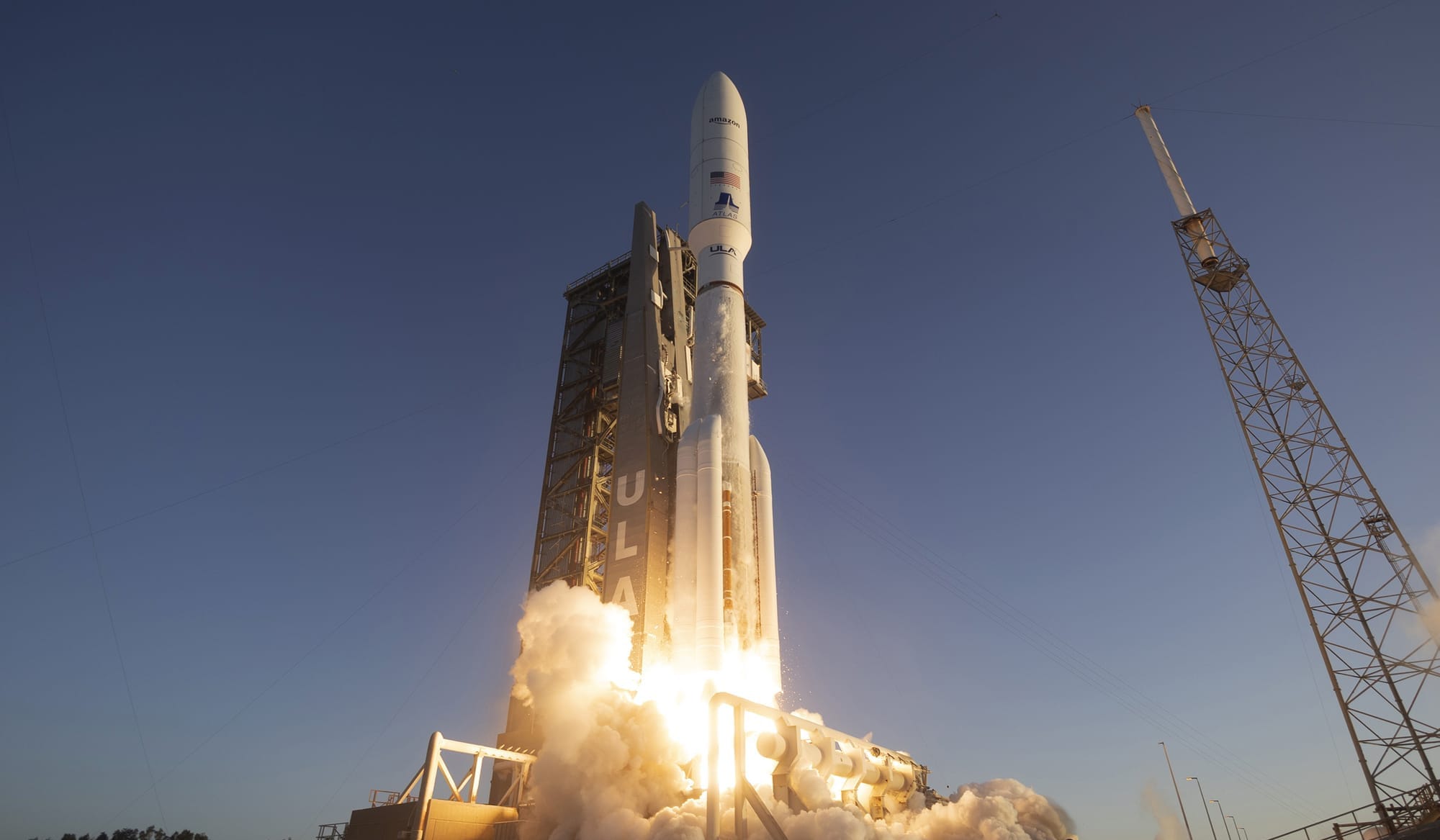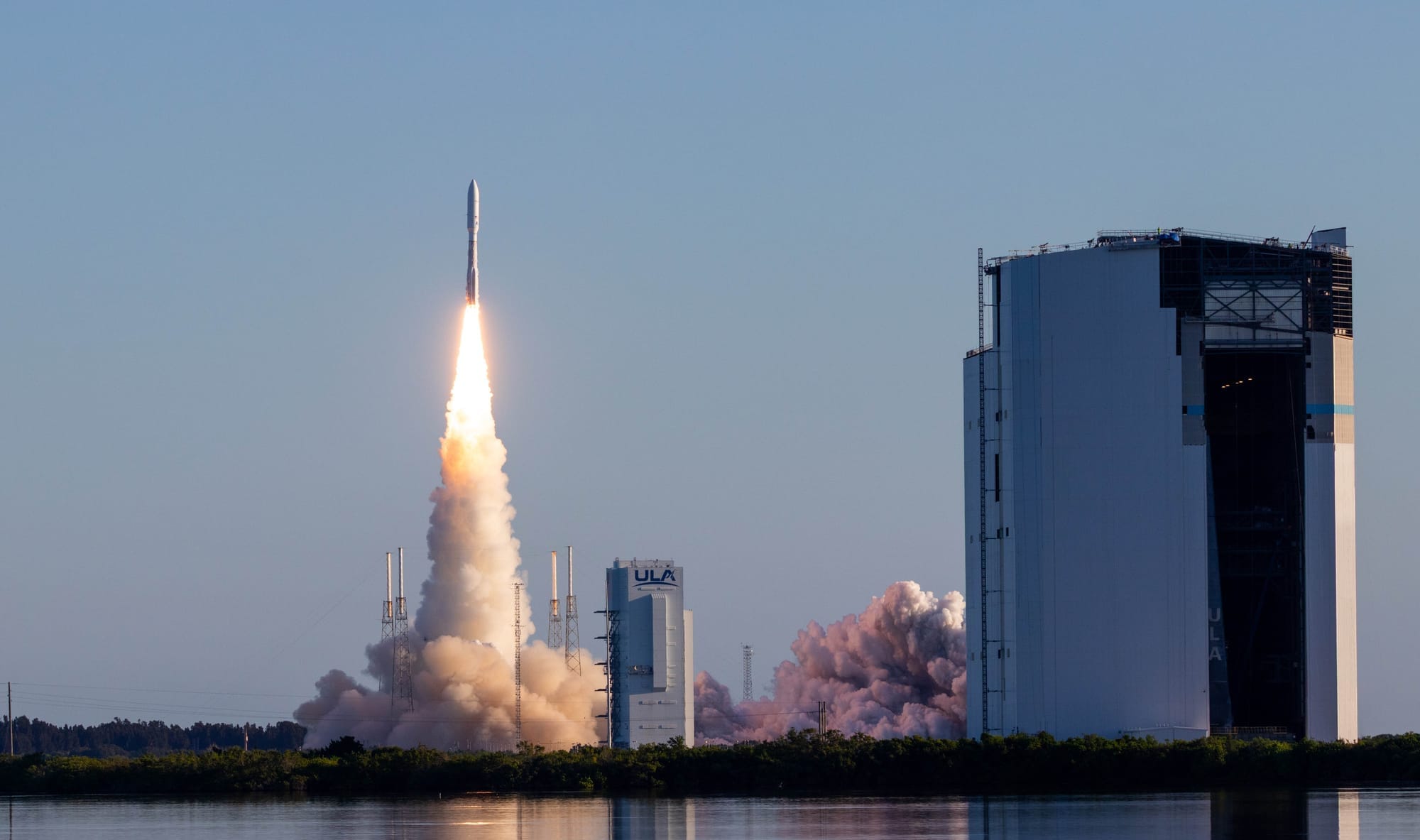Table of Contents
United Launch Alliance's Atlas V rocket roared from Space Launch Complex 41, in Florida, carrying the second batch of 27 satellites for Amazon's Kuiper internet-providing mega-constellation into low Earth orbit on June 23rd.
In the hours following launch, it was announced that the KA-02 (for Kuiper Atlas 2) mission had deployed the satellites from Atlas V's Centaur upper-stage. This mission, like the previous Kuiper launch, utilized Atlas V's most powerful configuration, with five solid rocket boosters, a five-meter fairing, and a single RL-10 engine on Centaur, to lift the group of satellites.
Six more Atlas V's are being prepared to launch Amazon's Kuiper satellites, before switching to United Launch Alliance's new Vulcan rocket. Gary Wentz, United Launch Alliance Vice President of Government and Commercial Programs, commented on the partnership to deploy Kuiper, saying:
"We are proud to continue our strong partnership with Amazon and empower their mission to bridge the digital divide through reliable satellite technology," – "ULA, working as a catalyst to global connectivity in collaboration with Amazon, enables delivery of these critical satellites designed to drive innovation and connect the world."
With the launch of a second group of satellites, Amazon now has 54 spacecraft in orbit, out of a planned total of 3,236. Kuiper satellites are currently headed to an orbital altitude of around 630 kilometers, with an inclination of 51.9 degrees, to begin offering internet services to customers.
Take a look at this @ULAlaunch clip of the first Kuiper satellites being released into low Earth orbit approximately 280 miles above the planet. Deployment takes place over a 15-minute period after launch, with satellites released three at a time from the dispenser system. pic.twitter.com/bZ1zUy3IWs
— Project Kuiper (@ProjectKuiper) May 2, 2025
Deployment of 27 Kuiper satellites following the KA-01 mission in April, via Amazon's Kuiper on Twitter.
Following the deployment of further satellites, services from Kuiper are planned to be available later this year at speeds of up to one gigabit per second.
Teams working on Kuiper have been moving quickly to ensure routine launches for the constellation, with Rajeev Badyal, Vice President of Technology for Kuiper, noting:
"The success of our first full-scale Kuiper mission in April meant we could move immediately to our next launch. All 27 satellites for our KA-02 mission were fully integrated within 17 days of that first launch ... Thanks to the entire team for the quick turnaround."
In order to meet a deadline with the U.S. Federal Communications Commission, half of the Kuiper's constellation, around 1,600 satellites, will need to be launched by mid-2026. Currently, Amazon has bought over eighty launches to deploy the constellation, including launches atop of Europe's Ariane 6, Blue Origin's New Glenn, United Launch Alliance's Atlas V and Vulcan, as well as SpaceX's Falcon 9. Additionally, Amazon has invested 140 million United States Dollars in a spacecraft storage and integration facility at Cape Canaveral to streamline launch preparations.
To assist in competing against other internet mega-constellations, Amazon has partnered with Japan's Nippon Telegraph and Telephone, America's Verizon, and the UK's Vodafone to bring services directly to consumers. Furthermore, the company is teaming up with Airbus to provide its airliners with in-flight connectivity.
RocketGPT
Ahead of today's Kuiper mission, SpaceNews reported that United Launch Alliance is trialing a version of OpenAI's government-compliant artificial intelligence chatbot to streamline the company's operations. Currently, the system, dubbed 'RocketGPT', is being utilized by about 150 employees via Microsoft's Azure cloud platform. Deploying 'RocketGPT' is reported to have taken several months to ensure security compliance requirements while fitting the company's specific needs.
Chief Executive Officer of United Launch Alliance, Tory Bruno, expects the tool to help with “tedious, time-consuming things” like report writing, government proposals, and flight telemetry analysis while boosting productivity. However, Bruno also emphasized that artificial intelligence functions as a research assistant rather than a job replacement, requiring extensive training on large datasets and human oversight for final products.
What is Atlas V?
Atlas V is United Launch Alliance's oldest two-stage rocket in service. The rocket is currently planned to be replaced by Vulcan when it retires before 2030.
The first-stage is powered by a single RD-180 generating 390 tons of thrust burning rocket-grade kerosene and liquid oxygen for four minutes and thirteen seconds. The RD-180 is manufactured by NPO Energomash in Russia.
The second-stage is powered by either one or two RL-10 engines generating 10 tons of thrust each while burning liquid hydrogen and liquid oxygen for up to fourteen minutes and two seconds. Aerojet Rocketdyne, an L3Harris Technologies Company, manufactures the RL-10 engines.
Atlas V can also launch with between zero and five GEM-63 solid rocket motors to augment the rocket's thrust and payload capability. Each booster burns a solid propellant, consisting of Hydroxyl-terminated polybutadiene and Aluminum-Ammonium perchlorate, generating 169 tons of thrust each for a believed one minute and thirty-four seconds. Northrop Grumman manufactures the solid rocket boosters for use with United Launch Alliance.
Atlas V also has eleven different configurations with the following payload capacities: up to 18,814 kilograms to low Earth orbit, up to 8,900 kilograms to geostationary transfer orbit, or up to 3,850 kilograms to geostationary orbit.






